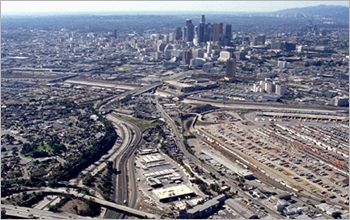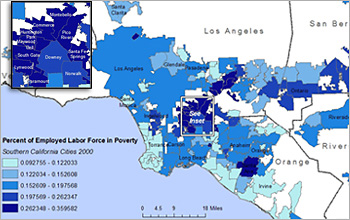All Images
Research News
Economic Structure Drives Working Poverty in Los Angeles Region

As the nation's second largest metropolitan region (second only to New York/New Jersey/Long Island), greater Los Angeles has an economic and industrial base of technology, aerospace, manufacturing, entertainment and services as complex and diverse as its population.
Credit: Geoffrey DeVerteuil

The geographic distribution of working poverty, which drives overall poverty concentration patterns, is intimately linked to the region's economic structure and can eventually impose costs on wealthier suburbs. The technology boom in Southern California has driven increases in high-wage professional, technology and service jobs, and low-wage domestic service jobs in affluent suburbs. Simultaneously, in the cities, the manufacturing sector has shifted from well-paying, unionized jobs to low-wage, non-union jobs without benefits.
Credit: Michael Dear

High concentrations of working poverty and overcrowding can increase the cost of providing human services, low-cost housing, education, public transportation and fire and police protection. Local municipalities grapple with the fiscal challenges of subsidizing working poverty.
Credit: Michael Dear

Greater Los Angeles is home to an economically polarized and culturally diverse population of more than 16 million. Of that total, some 4.5 to 5 million are living in poverty, and approximately 3.5 million are experiencing working poverty.
Credit: Pascale Joassart-Marcelli
Download the high-resolution JPG version of the image. (474 KB)
Use your mouse to right-click (Mac users may need to Ctrl-click) the link above and choose the option that will save the file or target to your computer.

Local governments in poor communities often attempt to fund the growing costs of working poverty by luring new businesses to create local jobs and increase income. This strategy can reduce necessary services to residents while creating more low-paying jobs and perpetuating the cycle of working poverty.
Credit: Pascale Joassart-Marcelli
Download the high-resolution JPG version of the image. (376 KB)
Use your mouse to right-click (Mac users may need to Ctrl-click) the link above and choose the option that will save the file or target to your computer.


